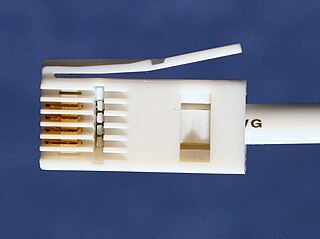The Sinclair QL is a personal computer launched by Sinclair Research in 1984, as an upper-end counterpart to the ZX Spectrum.

In telecommunications, an acoustic coupler is an interface device for coupling electrical signals by acoustical means—usually into and out of a telephone.
GeoPort is a serial data system used on some models of the Apple Macintosh that could be externally clocked to run at a 2 megabit per second data rate. GeoPort slightly modified the existing Mac serial port pins to allow the computer's internal DSP hardware or software to send data that, when passed to a digital-to-analog converter, emulated various devices such as modems and fax machines. GeoPort could be found on late-model 68K-based machines as well as many pre-USB Power Macintosh models and PiPPiN. Some later Macintosh models also included an internal GeoPort via an internal connector on the Communications Slot. Apple GeoPort technology is now obsolete, and modem support is typically offered through USB.
In the United Kingdom, Packet Switch Stream (PSS) was an X.25-based packet-switched network, provided by the British Post Office Telecommunications and then British Telecommunications starting in 1980. After a period of pre-operational testing with customers the service was launched as a commercial service on 20 August 1981. The experimental predecessor network (EPSS) formally closed down on 31 July 1981 after all the existing connections had been moved to PSS.
Sinclair Research Ltd is a former British consumer electronics company founded by Clive Sinclair in Cambridge. It was originally incorporated in 1973 as Westminster Mail Order Ltd, renamed Sinclair Instrument Ltd, then Science of Cambridge Ltd, then Sinclair Computers Ltd, and finally Sinclair Research Ltd. It remained dormant until 1976, when it was activated with the intention of continuing Sinclair's commercial work from his earlier company Sinclair Radionics, and adopted the name Sinclair Research in 1981.

Micronet 800 was an information provider (IP) on Prestel, aimed at the 1980s personal computer market. It was an online magazine that gave subscribers computer related news, reviews, general subject articles and downloadable telesoftware.

Alex was the name of an interactive videotex information service offered by Bell Canada in market research from 1988 to 1990 and thence to the general public until 1994.

The ZX Microdrive is a magnetic-tape data storage system launched in July 1983 by Sinclair Research for its ZX Spectrum home computer. It was proposed as a faster-loading alternative to the cassette and cheaper than a floppy disk, but it suffered from poor reliability and lower speed.

Standard Telephones and Cables Ltd was a British manufacturer of telephone, telegraph, radio, telecommunications, and related equipment. During its history, STC invented and developed several groundbreaking new technologies including pulse-code modulation (PCM) and optical fibres.
The British Approvals Board for Telecommunications (BABT) is a telecommunications certification body.

The BT Archives is an archive preserving the documentary heritage of the British telecoms company BT and its public sector predecessors. It is designated an official place of deposit for Public Records, for those records created prior to BT's privatisation in 1984.
The International Packet Switched Service (IPSS) was the first international and commercial packet switching network. It was created in 1978 by a collaboration between Britain's Post Office Telecommunications, and the United States' Western Union International and Tymnet.
Computer Consoles Inc. or CCI was a telephony and computer company located in Rochester, New York, United States, which did business first as a private, and then ultimately a public company from 1968 to 1990. CCI provided worldwide telephone companies with directory assistance equipment and other systems to automate various operator and telephony services, and later sold a line of 68k-based Unix computers and the Power 6/32 Unix supermini.

AT&T Merlin is a corporate telephone system by American Telephone and Telegraph (AT&T) that was introduced in late 1983, when it was branded American Bell Merlin. After the breakup of AT&T in 1984, it was rebranded and later also supplied by Lucent and Avaya.

Telecommunications engineering is a subfield of electronics engineering which seeks to design and devise systems of communication at a distance. The work ranges from basic circuit design to strategic mass developments. A telecommunication engineer is responsible for designing and overseeing the installation of telecommunications equipment and facilities, such as complex electronic switching systems, and other plain old telephone service facilities, optical fiber cabling, IP networks, and microwave transmission systems. Telecommunications engineering also overlaps with broadcast engineering.
Manx Telecom Ltd. is the primary provider of broadband and telecommunications on the Isle of Man. It is owned by Basalt Infrastructure Partners LLP.

British telephone sockets were introduced in their current plug and socket form on 19 November 1981 by British Telecom to allow subscribers to connect their own telephones. The connectors are specified in British Standard BS 6312. Electrical characteristics of the telephone interface are specified by individual network operators, e.g. in British Telecom's SIN 351. Electrical characteristics required of British telephones used to be specified in BS 6305.
The BT Merlin M4000 was a Personal computer sold by British Telecom during the 1980s as part of the Merlin range of electronic machinery for businesses. It was not developed by BT but was a rebadged Logica VTS-2300 Kennet, and a completely different machine from the Merlin Tonto which was a rebadged ICL OPD.
The Customer Service System (CSS) of the BT Group is the core operational support system for BT, bringing in 70% of income for the company. BT rolled out CSS nationally in 1989 and provided an integrated system for telephony—order handling, repair handling and billing.











